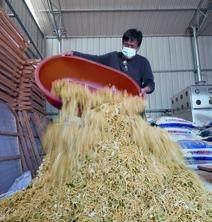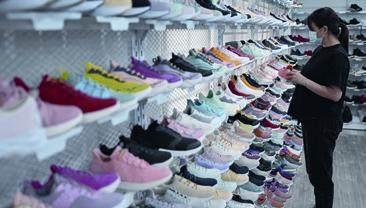NEW DRIVER OF URBANIZATION
2022-06-09ByJiJing
By Ji Jing
Jujube trees are invaluable for the residents of Zhanhua, a county in Shandong Province. Some jujube buds are processed into tea. When the jujube trees are in full blossom, bees will produce honey, bringing income for the locals. The fruit is sold across the country. Even the jujube wood is made into stools, walking sticks and handicrafts.
There has been a widening variety of products made from jujube trees in the county in recent years and jujube planting and processing has become the countys pillar industry. Last year, the output of jujube in Zhanhua reached 305 million kg and the output value of the jujube industry surpassed 4.5 billion yuan ($675 million).
Industries are the foundation for the development of counties as generators of jobs and revenue. While crop and animal farming are concentrated in the rural parts of counties, agricultural processing and other industries tend to gather in county seats. Industries in county seats attract surplus rural workers to settle in them, promoting urbanization; and adding more value to agricultural products, and boosting local incomes.
Urbanization driver
China will further spur the development of county seats to promote urbanization, according to a recent guideline jointly released by the general offices of the Communist Party of China Central Committee and the State Council.

The move is also expected to help drive the development and modernization of rural areas, and expand domestic consumption and investment, while creating more jobs and improving the lives of residents in county seats, an official with the National Development and Reform Commission (NDRC) recently told the press.
In 2021, permanent urban residents accounted for 64.72 percent of Chinas population, according to the NDRC. China aims to raise its urbanization rate to 65 percent during the 2021-25 period.
As of the end of 2021, China had 910 million permanent urban residents, of whom 160 million were in county seats, official data shows.
The guideline said that by 2025, the country will see a bevy of county seats improved in a well-rounded way, with more rural people working and residing in county seats.
According to the guideline, counties featuring specialty industries will be further encouraged. More specifically, those with resource and transportation advantages will be further supported to develop distinctive pillar industries. These counties will create more jobs and feature industries such as commerce and trade, advanced manufacturing, and culture and tourism.6316EE3E-390C-4355-81EF-9E64DC6C3B7D
Specialty counties
There are already many counties with specialty industries in China. For instance, 40 percent of Chinas sports shoes are produced in Jinjiang, Fujian Province, 70 percent of socks come from Zhuji, Zhejiang Province and 75 percent of eyeglass lenses are from Danyang, Jiangsu Province.
In Julu, a county in Xingtai City of Hebei Province, farmers pick honeysuckle flowers, a herb for traditional Chinese medicine (TCM).
Located on the North China Plain, the county has ample sunshine and alkaline soil, suitable for the growth of the herb. Now the county has nearly 9,000 hectares of honeysuckle flowers, with an annual output value of over 2 billion yuan($300 million). The countys output of the herb accounts for over 60 percent of the national total, making it the largest production base in China.

However, in the past, farmers derived limited income from growing honeysuckle as the flowers were sold only as a TCM herb and the prices often fluctuated greatly.
In recent years, the county has extended the industrial chain of the plant through processing. A group of companies have been established to process the plant, producing over 30 varieties of products including honeysuckle flower tea and skincare products.
The honeysuckle flower industry has created jobs and increased local residents incomes. A large number of people from Julu and nearby counties have found jobs in the county and many of them have bought apartments and settled down there. The increased population has boosted the businesses of shops and restaurants.
Li Genmao, a farmer from Weijiazhuang Village in the county, who started to plant honeysuckles five years ago, said his income has increased a lot and he has not only bought a new car but also a new apartment in the county seat.
Tong Zhihui, a professor with the School of Agricultural Economics and Rural Development at Renmin University of China, said the aim of developing counties with specialty industries is to attract rural people to settle down in county seats.
As an increasing number of rural people migrate to counties, they create more demand for housing, transportation, education and medical care, which prompts more investment into infrastructure, commerce and public services, forming a virtuous cycle.
“We found through our research that counties with sound industrial development have better infrastructure and public services and are therefore more livable. For instance, some counties medical services have improved and residents no longer need to go to large cities for medical treatment. The cultural and entertainment sectors are also thriving as there are more cinemas, cafes and gyms,” Tong said.6316EE3E-390C-4355-81EF-9E64DC6C3B7D
Ni Pengfei, Director of the Center for City and Competitiveness at the Chinese Academy of Social Sciences said there are two things that attract people to counties: employment opportunities and public services.
“In the first phase of the urbanization process, people go to cities not to live permanently but to work and make money with which to build houses in their home villages. In the second phase of urbanization, the purpose of going to cities has become not only to work but also to live there,” Ni said.
The NDRC said that China will devise differentiated paths of development for five major types of county seats: those close to metropolises; those with an industrial edge or specific function; agriculture-intensive seats; those of ecological significance; and those suffering from population outflows.
Ni said as different counties have different conditions, they should follow different development paths. For instance, although many counties close to metropolises have fewer employment opportunities, people still want to live there because they want to work in the metropolises. Such counties should focus on improving public services to better serve these people. Population inflow also drives these counties industrial development.
Some counties not close to metropolises and regional central cities, such as many of those in northeast China, have good public infrastructure and services but are lagging in industrial development. These counties should improve their business environment to promote entrepreneurship and attract investment. Only by boosting industrial development can they draw more people.
Counties far from large cities and densely populated areas have great development potential but have weak industries and public services. For these counties the government should guide the development of public services and private capital should also be channeled to the improvement of infrastructure and public services. At the same time, business environments should be improved to accelerate industrial development.
Ni said the development of these counties is important because, on the one hand, it will help prevent the excessive population influx into large cities and on the other hand, it can boost the revitalization of villages around the county seats and hence realize common prosperity of the country. BR6316EE3E-390C-4355-81EF-9E64DC6C3B7D
